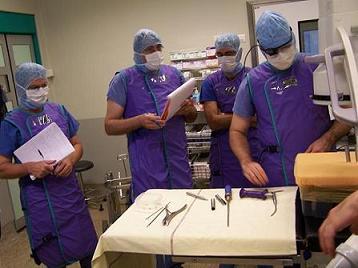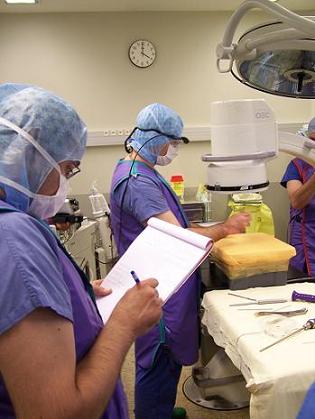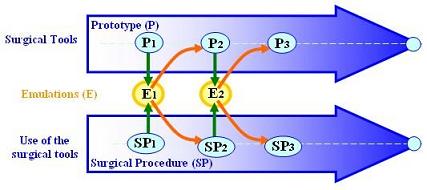DESTIN (english version)
Application of an Innovative Design Methodology in the Surgical Domain
Partners :
![]() laboratoire G-SCOP,
laboratoire G-SCOP,
![]() laboratoire LIG,
laboratoire LIG,
![]() CHU, service de traumatologie.
CHU, service de traumatologie.
Application of an Innovative Design Methodology in the Surgical Domain
mirror site of : http://www.vrl-kcip.org/spip.php ?article423
NEED FROM THE INDUSTRIES
In all the production domains, there is usually a difference between the user’s idea and the designer’s proposal product. This variable difference depends on the design process methodology used by the enterprise. In the surgical domain, companies [1] explain that this problem appears more seriously because of the large space between the proficiency of the user and the designer. Moreover, there is a big difficulty of medical terms routinely employed by the surgeon to explain his need, which causes to reduction of an instantaneous comprehension by designers. Since the relation between the surgeon and the designer plays an important role in the design process, a little disturbance ends in a dysfunction in the definition cycle of the product. A specific need from specialist enterprises is to modify the design process for better understandings and more complementarities between surgeons and designers.

G-SCOP WORK AND CONTRIBUTION
In the studies of the mechanical design process, the integration of knowledge into the process is an important point of view for formalising knowledge. Studies of how to describe the evolution of the problem and its solution in the design process are needed to be able to evaluate the product in real-world projects. They also provide directions for improving it and the product enhance the general understanding of what co-evolution contributes to design. The G-SCOP laboratory in Grenoble has a profound experience in design process methodology, especially in product lifecycle trades integration. In collaboration with the MISIT Program in TU Delft, it proposed to the industries and the surgeons to contribute to such an approach by integrating the user knowledge and the requirements evolution in the innovative surgical tools process design.
WHICH APPROACH ?
To reduce the life cycle duration and to increase the understanding between surgeons and designers, the G-SCOP team proposed to integrate the user centred design (UCD) approach. The main advantage of the UCD approach is that a deeper understanding of the psychological, organizational, social and ergonomic factors that affect the use of computer technology emerges from the involvement of the users at every stage of the design and evaluation of the product. The involvement of users assures that the product will be suitable for its intended purpose in the environment in which it will be used. This approach leads to the development of products that are more effective, efficient, and safe. The UCD methodology allows designers to imagine and create an appropriate product to the user. Unfortunately in some cases, this product can become too much specific and adapted only to one user, not to a whole of users. For these reasons and to avoid the case of a too specific tool, we will discuss the proposal to experiment the Scenario-Based Design (SBD) methodology. This approach allows designers to create new tools and devices with user participation during all the primary phases of the design process. In SBD, descriptions of situations become more than just orienting examples and background data, they become first-class design objects. Scenario-based design literally takes the adage that a tool is what people can do with it, the consequences it has for them and for their activities that use it.

RESULTS OF THE WORK
The result of our work with Dr. Jèrôme Tonetti and Dr. Hervé Voillat from the Service Orthopédie-Traumatologie of the hospital of Grenoble is the design of a new mechanical surgical tool (for their collaboration ?). After three emulations (from June 2006 to June 2007) realised on mannequin, the next step will be a last test in January using a corpse before the use for a real operation. A patent is in preparation. Why the existing methodologies couldn’t be used ? There are two approaches in this case, first talks about the co-evolution of problem and the solution, and second proposes the simulation like a reliable situation for verifying the solution. An other result of our work is the proposition of a new model described as the schematic form below that the confrontation between declared need and proposed solution may be used not only as the insight of clarifying the need but also for the modification of the solution. This point of view matters in the condition that the use (which could be considered like a problem) couldn’t be clearly defined, for example in the innovative surgery. In this proposition, each arrow shows progress of its subject with time. The procedure between one positions to another pass through another stage called emulation (E). Emulation is a physical experience or test (against simulation in the virtual environment) but in the unreal environment. It means a confrontation between instrument (prototype P) and the use (surgical procedure SP), including the user. In other words, in emulation the prototype of instrument is employed by the user in a modelled situation of use.

FUTURE OF THE WORK
To increase the efficiency of the designers after the emulations, the proposition of appropriate software is also being considered. The Observer XTTM [2] software allows annotating one or more video flows, during or after the registration. This software is used in lots of research domains, especially in psychology in the case of comportment and social interaction studies, but also in neurosciences and systems usability testing. In this project a formula based on the surgical gestures has been proposed to collect the essential data for the designer. Each gesture has been precisely defined from a group of dedicated qualifiers. After the annotation of the whole surgical operation process, which is composed of actions and gestures, it has been possible to constitute a grid of events. From this grid and from the mechanical functions of the surgical tool, the idea is to give the best conclusions to the designer concerning the evolution of the prototype. The aim is to propose this engineering software tool to the design engineers for reducing the process design duration of innovative surgical tools.
ADAPTATION IN OTHER CONTEXT
The complexity of the specific context needs a specific methodology to be well designed with taking into account a maximum of the users constrains. To that aim, a new co-evolutionary design process methodology has been proposed where the progress of the product and the use-adapted procedure become visible. This methodology can be applied in several other domains where the designers have difficulties to integrate the knowledge of the user in the design process as a representative of him, neglecting many details. But once user is an expert, the whole idea of integrating knowledge will be on incertitude.
[1] Medtronic, Tornier, Kiscomedica, Biomet Merk
[2] The Noldus Society : The Observer XTTM is a professional software package for the collection, analysis and presentation of observational data : http://www.noldus.com/site/doc200401012.